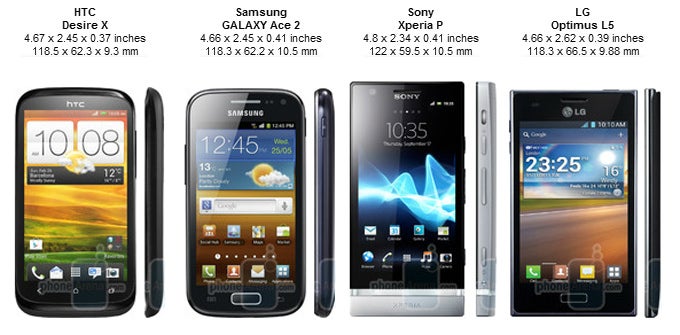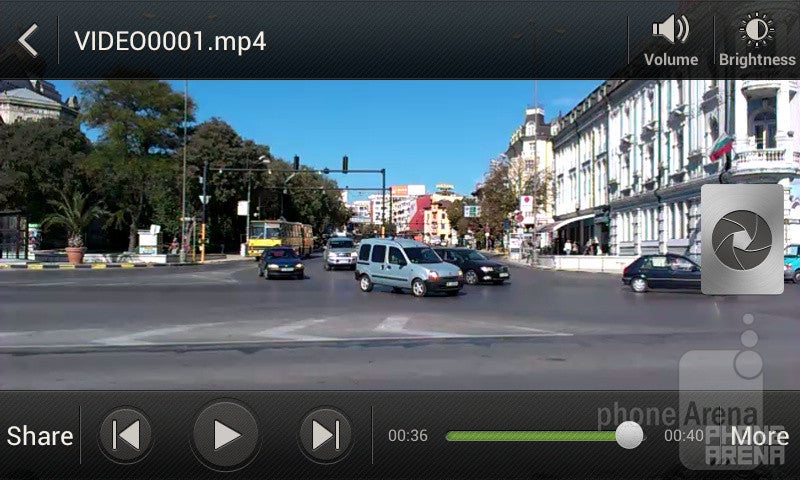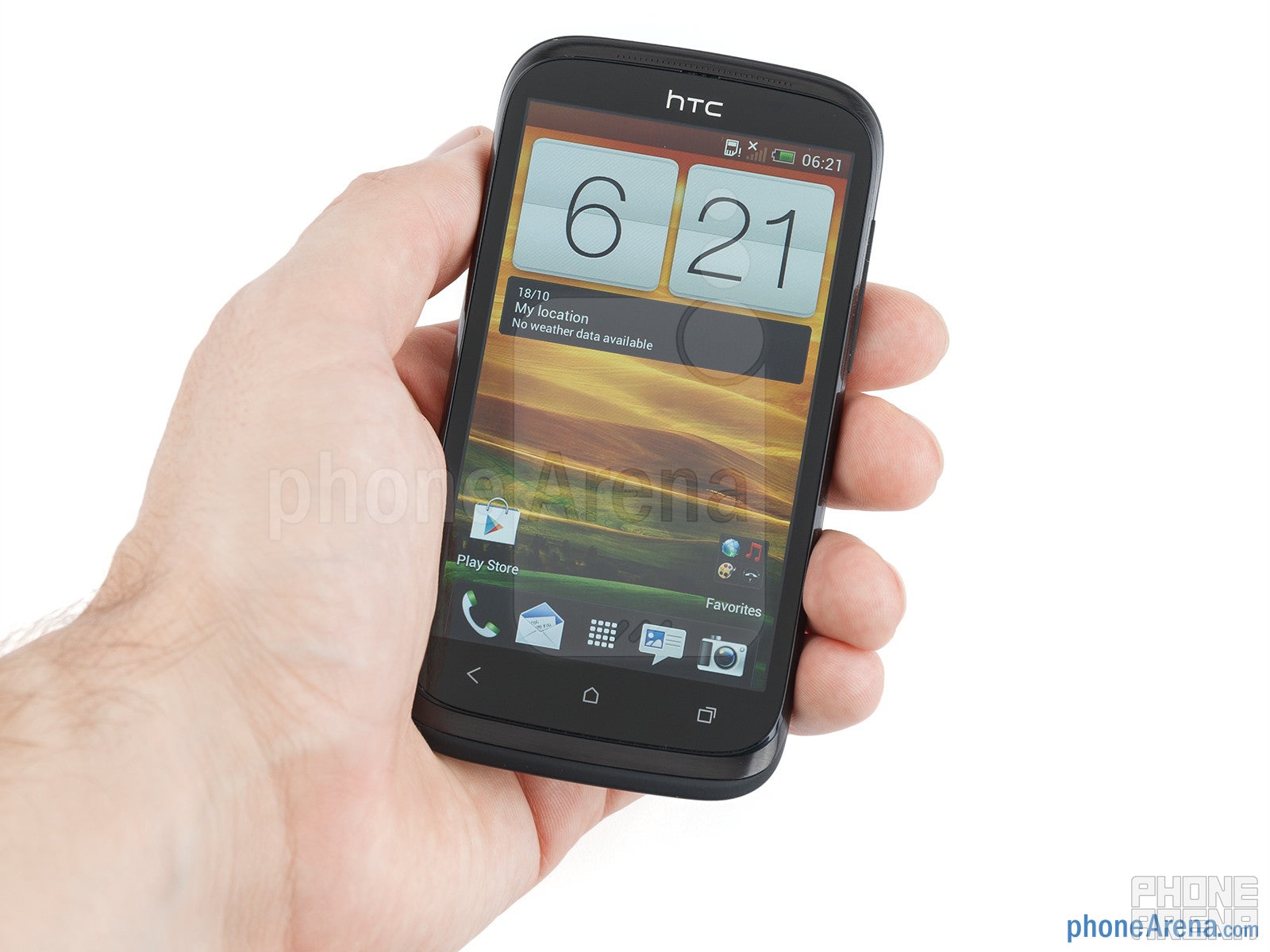HTC Desire X Review

Introduction:
Last time when HTC had a serious contender positioned in the mid-range Android category was when the One V hit the shelves. It was a cute little handset with good build quality and adequate performance. However, it has been a while since then, so we guess the maker decided to spice things up a bit with a new device.
Introducing the HTC Desire X – a smartphone that fits perfectly in the mid-range tier with its 4-inch screen, 1GHz dual-core processor, 4GB of storage and 5-megapixel auto-focus camera. Yeah, perhaps those features don't seem too exciting at first, but when you add the smartphone's reasonable pricing to the equation, it suddenly seems like we have a potential winner on our hands. Or do we? Let's find out!
The box contains:
- Wall charger
- microUSB cable
- Wired stereo headset
- CD with the user manual
- Quick start guide
- Warranty and other documentation
Design:
To just say that the HTC Desire X looks nice would be a gross understatement In fact, the smartphone is surprisingly attractive and is surely among the best-looking Android mid-rangers we've come across lately. With its gently curved back side, the device fits like a glove when being held and feels just like an extension of your hand – comfortable to grasp and easy to operate.

You can compare the HTC Desire X with many other phones using our Size Visualization Tool.
There are a few things, however, that HTC could have paid more attention to. First and foremost, the physical buttons on the Desire X – the lock button on top and the 2-button volume rocker on its right side, are a pain in the rear to use due to their poor tactile response and insufficient travel. Another thing that bothers us is just how easily fingerprints stick to the plastic back plate of the smartphone, at least on its black version, and how tricky it is to get them off afterwards.
Display:
Super LCD 2 is the technology used to make the 4-inch screen on the HTC Desire X, just like the case is with the HTC One X flagship. That explains why the display panel is so pleasing to the eye, with its bright, lively colors and impressively wide viewing angles. Furthermore, the screen retains a decent level of visibility even when the sun is shining right at it, although using your hand to provide some shade might be required in extreme occasions. As far as details are concerned, the 480 by 800 pixels of resolution is so 2010, but it is acceptable for a display of this size, especially when a traditional RGB pixel arrangement is in use.
Interface:
HTC Sense 4.0 running on top of Android 4.0 Ice Cream Sandwich is not just a custom interface – it is an entirely different experience. There are barely any traces of the platform's stock feel, but we aren't really complaining because the end result is quite enjoyable to use. To start, there's HTC's trademark “pull the ring” lock screen with four customizable app shortcuts present on it. In addition to all the widgets available in ICS, you also get HTC's acclaimed clock, weather, social networking widgets, and a whole bunch of pretty wallpapers to choose from. Not to be forgotten is the on-screen keyboard, with its huge, easy-to-hit buttons and on-the-fly auto-correct feature that takes care of your typos.
Software:
HTC has loaded the Desire X with several useful apps, and Rescue is one of them. Powered by the LogMeIn service, it is used for getting remote technical support from an HTC representative should the user be experiencing difficulties with their smartphone. So if your HTC starts acting up and nothing seem to help, this is the app to resort to. In addition, HTC has thrown in an application that allows contact information and other data to be transferred from your old device, depending on its technical capabilities. Last but not least, there's the Tasks app that allows the user to make their own to-do lists that sync with their Google account.
Processor and memory:
Don't get excited about the fact that the HTC Desire X has a 1GHz dual-core Snapdragon S4 SoC and 768MB of RAM. The chip that is used is of the low-tier Snapdragons, namely the MSM8225, which explains the rather average benchmark scores that we got during our tests. Nevertheless, what truly matters is that the processor is snappy enough to handle every-day operations without any troubles. Lags are extremely rare, the interface runs without skipping a frame, and apps launch in an instant. Even the 3D games we tried were more than playable on the HTC Desire X.
| Quadrant Standard | AnTuTu | NenaMark 2 | |
| HTC Desire X | 2361 | 4932 | 33,6 |
| Samsung Galaxy Ace 2 | 1953 | 4095 | 32,4 |
| Sony Xperia P | 2187 | 5404 | 29,4 |
| Samsung Galaxy Nexus | 2000 | 5503 | 24 |
The user-available storage space on the HTC Desire X is anything but generous. There is about 1GB for applications and another gig for music, photos, and other media, which will run out before you know it. Therefore, purchasing a microSD card along with the handset is almost inevitable.
Web browser:
There are several significant drawbacks that make the stock web browser on the HTC Desire X somewhat frustrating to use. First of all, rendering heavy web pages takes a while, especially when zooming in or out. Another thing that bothers us is that each time we go back to a tab we've previously opened, the browser automatically reloads it. On the bright side of things, the browser has the very handy option to clear all images from the page and leave the text only, displayed using a large, legible font – perfect for reading news, articles and blog posts. Adobe Flash comes pre-loaded, so you'll be able to enjoy those embedded online videos, and there is a toggle switch to disable the plug-in when it isn't needed.
Camera:
Photos taken with the HTC Desire X and its 5-megapixel camera look fine, but despite the presence of the dedicated HTC ImageChip, they aren't anything to make your jaw drop. There is plenty of detail in the images considering the smartphone's class, but colors are cold and lifeless, and once you start zooming in, the traces of digital noise become more and more apparent. However, panorama photos turn out worthy of being shared with the world. Low-light photos taken with a flash, on the other hand, you might want to keep to yourself.

Outdoor samples
What we are happy to see is that the camera app launches quickly and the shutter lag is nearly non-existent. Besides, you get a whole bunch of built-in photo filters and shooting modes. Last but not least, you can take full-resolution photos while capturing video. Speaking of video, the maximum resolution, at which it can be taken is 800 by 480 pixels. That is quite disappointing, considering that many mid-range Android devices can already shoot at 720p. Due to the low resolution and lack of detail, videos are barely passable.
HTC Desire X Sample Video:

Multimedia:
The music player that comes along with HTC Sense is definitely versatile enough to meet the needs of even the more demanding users. In addition to all the basic features, such as the lock screen controls and home screen widget, it has several cool tricks up its sleeve. For example, it can play back audio from a media server connected on the network, and the SoundHound integration allows you to identify the song currently playing, in case its details happen to be missing. There is also support for Beats Audio enhancements, which turns up the volume a notch and makes beats more punchy.
MPEG4 or DivX video can played back via the HTC Sense image gallery, and the maximum resolution supported is 800 by 480 pixels. All unsupported resolutions are filtered out, so don't be surprised if your video files happen to be missing from the list. We tested out a third-party video player only to find out that it was also unable to play back most of our HD samples, so don't even bother loading any 720p movies on the Desire X.

The device can play MPEG4 or DivX videos
Call quality:

Battery life:
With a capacity of 1650 mAh, the removable battery inside the HTC Desire X can deliver 6 hours of 3G talk time, which is within the acceptable norms. In stand-by mode, the smartphone should last for about a month before it needs to be recharged.
Conclusion:
Chances are thatthe HTC Desire X is a phone that you won't regret getting. Its maker has managed to deliver a reasonably priced smartphone that looks good enough to make you want to show it off in public. Besides, the handset runs as smoothly as a contemporary Android device should and its front is graced by a screen of above average quality. Yet be aware of the fact that the HTC Desire X has its flaws. For example, you'll have to live with the horrible physical keys it has been cursed with and the lack of support for HD video. The performance of the stock web browser also leaves something to be desired.
If you are interested in an alternative to the HTC Desire X, there's the Sony Xperia P, which might be priced slightly higher, but offers a much better camera and an amazingly bright display packed inside an aluminum body. In case you are into AMOLED displays, the Samsung Galaxy S III Mini might grab your attention with its 4-inch WVGA screen, and you'll also get a front-facing camera as a bonus. If you need something a bit more affordable, you might give the HTC One V a try as it delivers decent performance at a noticeably lower price.
HTC Desire X Video Review:










Things that are NOT allowed: